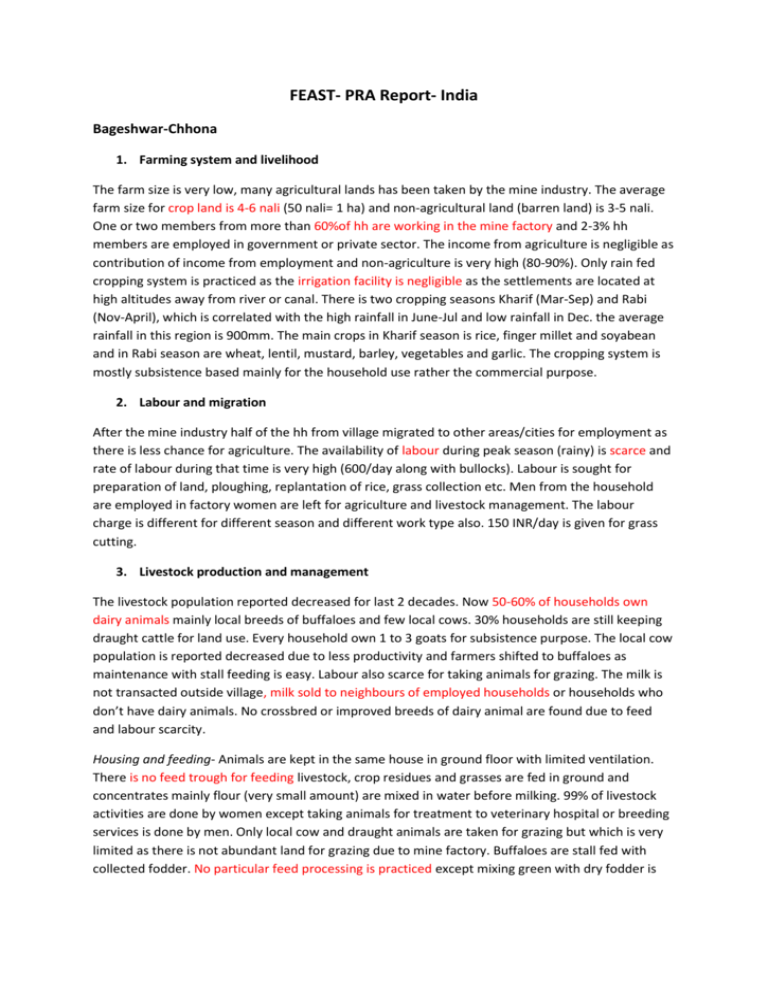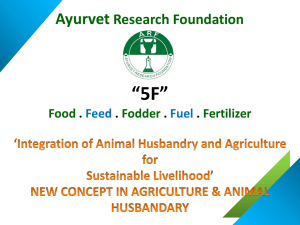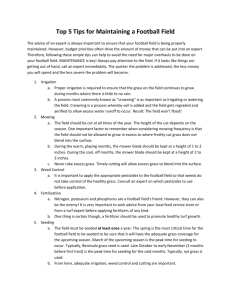Report of FEAST
advertisement

FEAST- PRA Report- India Bageshwar-Chhona 1. Farming system and livelihood The farm size is very low, many agricultural lands has been taken by the mine industry. The average farm size for crop land is 4-6 nali (50 nali= 1 ha) and non-agricultural land (barren land) is 3-5 nali. One or two members from more than 60%of hh are working in the mine factory and 2-3% hh members are employed in government or private sector. The income from agriculture is negligible as contribution of income from employment and non-agriculture is very high (80-90%). Only rain fed cropping system is practiced as the irrigation facility is negligible as the settlements are located at high altitudes away from river or canal. There is two cropping seasons Kharif (Mar-Sep) and Rabi (Nov-April), which is correlated with the high rainfall in June-Jul and low rainfall in Dec. the average rainfall in this region is 900mm. The main crops in Kharif season is rice, finger millet and soyabean and in Rabi season are wheat, lentil, mustard, barley, vegetables and garlic. The cropping system is mostly subsistence based mainly for the household use rather the commercial purpose. 2. Labour and migration After the mine industry half of the hh from village migrated to other areas/cities for employment as there is less chance for agriculture. The availability of labour during peak season (rainy) is scarce and rate of labour during that time is very high (600/day along with bullocks). Labour is sought for preparation of land, ploughing, replantation of rice, grass collection etc. Men from the household are employed in factory women are left for agriculture and livestock management. The labour charge is different for different season and different work type also. 150 INR/day is given for grass cutting. 3. Livestock production and management The livestock population reported decreased for last 2 decades. Now 50-60% of households own dairy animals mainly local breeds of buffaloes and few local cows. 30% households are still keeping draught cattle for land use. Every household own 1 to 3 goats for subsistence purpose. The local cow population is reported decreased due to less productivity and farmers shifted to buffaloes as maintenance with stall feeding is easy. Labour also scarce for taking animals for grazing. The milk is not transacted outside village, milk sold to neighbours of employed households or households who don’t have dairy animals. No crossbred or improved breeds of dairy animal are found due to feed and labour scarcity. Housing and feeding- Animals are kept in the same house in ground floor with limited ventilation. There is no feed trough for feeding livestock, crop residues and grasses are fed in ground and concentrates mainly flour (very small amount) are mixed in water before milking. 99% of livestock activities are done by women except taking animals for treatment to veterinary hospital or breeding services is done by men. Only local cow and draught animals are taken for grazing but which is very limited as there is not abundant land for grazing due to mine factory. Buffaloes are stall fed with collected fodder. No particular feed processing is practiced except mixing green with dry fodder is practiced. The grass and crop residues are fed without chopping and there is 50% of wastage of fodder reported. Breeding and veterinary services- Natural service is preferred for buffaloes and 2 bulls are available in 1-4 km distance. Timely service is always a problem and longer inter-calving period due to this. AI is practiced for cows and service is provided by BAIF and AH department and paravets trained by ULDB (Uttarakhand Livestock Development Board). INR 500-700 is charged for one live calf for natural service and INR 200 is charged for AI. Breeding cost is considered expensive than other areas 4. Prioritised problems or issues 1. Less grass land and less quantity of grass is available 2. More feed cost towards purchase of grass from other areas 3. Water source is limited 5. Conclusion and recommendation Scarce crop land or grass land due to land grabbing by mine industry Migration and employment is high, scarcity of labour for livestock activities Cost for collection/purchase of grass is high No surplus milk to sell outside settlement, dominance of informal milk marketing to neighbours Interventions can be limited to conservation of grasses, chopping the fodder can decrease the waste. Interventions for the green fodder in crop land is limited as they use for subsistence staple food production Bageshwar- Saing 1. Farming system and livelihood The average farm size in this region is 15-20 nali/hh. There are 10% households with more than 20 nali/hh and less than 5% hhs have <5 nali/hh. Most of the settlements are near the river bank except one or two settlements which are located in the high altitudes in the same mountain region. 90% of households are having irrigation facility in 50% of their land. 90% of households are depending on the livestock and agriculture for livelihood. Dairy development is significant in this region after IFAD and CHIRAG interventions. As there is good irrigation facility is available, farming is done two seasons Rabi and Kharif season. Main cropping pattern in Kharif season are rice, finger millet, soyabean, banyard millet and pigeon pea. Wheat, barley, mustard and lentil are the man crops in Rabi season. The cropping pattern is associated with the feed availability to animals through crop residues. The farm outputs are sold in the nearby market which is 20-25 km distance. 2. Labour and migration Migration is very less from this region. 2-4 hhs migrated to nearby cities for purpose of education. 45 members are present in each household so availability of labour is not an issue. They hire labour for the land preparation, harvest yield, grass collection etc. the labour charge during peak season is INR 200/day and INR 400-500 along with bullock which is comparatively less than other region. The agriculture work is being done by men and women and livestock especially dairy management is done by women. 3. Livestock production and management Buffaloes population is dominant than cattle population. Each household own 1 buffalo and or one cow. All are local breed, no improved breed is found as they report that it is difficult to manage them with feed and disease management. Preference of buffaloes is linked with easy maintenance by woman. Local cow population is decreasing due to low productivity. Each household owns 2-3 goats for the subsistence purpose. Grass is collected after rainy season and stored as hay stacks; labour is hired for this purpose. Milk is sold in the nearby market through the co-operative marketing sytem which is assisted by CHIRAG and IFAD. Part of milk is sold to government based co-operative milk society (Anchal). The trust with Anchal decreased over years due to uncertain price and payment to producers. Housing and feeding- Buffaloes are stall fed, draught cattle and local cows are sent for grazing and household women accompanies them. Animals are fed in ground; no feed trough is available except 2 farmers, provided by IFAD project. There is huge grassland is available which is communal but they have been divided to each households informally. If anybody doesn’t have livestock they sell their grassland to others who have livestock. Some parts of grassland are left for only grazing where grass is not collected. Green fodder and dry grass are mixed and fed to animals. Concentrates of homemade is fed only to milking animals in limited quantity 200-400gm per day. The animal shed I located in same house lower floor is used for animals. They clean the house once a day. They put pine needles as bedding. Breeding and veterinary services- natural service is preferred for buffaloes breeding and INR 500 per live calf is charged. There are 2-3 bulls are available in 5-6 km distance. AI is done for cattle breeding from BAIF and AH department which is 10-15 km distance. The trend of improved cattle seems increasing with awareness and attitude towards dairy development. 4. Prioritised problems and issues a. Shortage of green fodder in summer (May, June) and winter(December and January) b. Lack of feeding knowledge for dairy animals c. Lack of AI service 5. Conclusion and recommendation a) Making availability of year round green fodder. Barley and oat can be promoted along with dual purpose wheat also. Wheat fodder can help for green fodder in December and January b) Make use of the irrigation facilities. Shall we try for berseem fodder? Promotion of Napier, Sita grass and Guinea grass which needs irrigation. This can help for fodder in summer? Good quality grass varieties can be promoted like Broom, Rye and Kucchi etc. c) Promotion of concentrate feeding either private feed or CHIRAG or Anchal feed. d) AI service can be supported with BAIF e) Promotion of chaff cutter for prevention of fodder wastage f) Silage making trial? Almora- Sult block As there are similarities in both the clusters of Saknara and Baseri except irrigation facility in Barkinda village, the report has been made combined together. 1. Farming system and Livelihood Around 60% of households in this region own average farm size of 15-25 Nali/hh. 20% of households own large farm size of >25 Nali/hh and 20% households own small farm size of <15 Nali/hh. Out of the total land 60% of land are cultivated and 40% of land are uncultivated or wasteland used for grass production. All the cultivated land is rain-fed except Barkinda village where few households have access to irrigation through river. The cropping pattern in this region during rainy season (Kharif) are Finger mellet, fox tail millet, banyard millet, rice, soyabean, grams etc. apart from this subsistence farming there are certain cash crops are cultivated in this season which are chilly, ginger and turmeric. There is main problem of wild animal damage to the crops, farmers prefer for these cash crops. Wheat, barley, lentil are the main crops cultivated during winter (Rabi) season. There is more uncultivated or waste land and also Vanpanchayat land is available for grass production for animals. Even though there is potential (grass land) for the dairy development, there is littlke improvement observed in this region. There is not many marketing channels are available for milk marketing. There are few villages with Anchal dairy co-operative with limited number of farmers. The main livelihood in this region is cash crops cultivation. Livelihood from dairy is limited even though there is potential. 2. Labour and migration Livelihood from agriculture is also limited due to damage by the wild animals, so farmers are changing their cropping pattern from food crops to cash crops. 20-30% households migrated to nearby cities or plain areas with regard to employment and education. The availability of labour is not a constraint, require labour during rice plantation, preparation of land and grass cutting etc. INR 300 is paid for men and INR 150 is paid for woman. Labour is not an issue in this region. Most of the land preparation and agricultural work is done by men and livestock related activities are carried by men. Each household one member is migrated for employment. 3. Livestock production and management Each household owns either one buffalo or a cow. Some households are having both. Buffalo population is dominant in this region. Draught cattle are available in all the settlements as they use for land preparation such as ploughing. Buffalo is considered as easy maintaining dairy animal. Animal dung is considered as main fertilizer for land. Improved dairy cattle is not found as the farmers reported that they need more feed, not suitable to this climate and more labour required. 23 goats are present in each household which is used for meat purpose. Previously there were many cows and replaced with buffaloes for easy maintenance with stall feeding due to wild animals and migration. Hiring labour is common for grass collection and storage. Milk is sold in nearby shops informally and also nearby households. In these selected area no milk is given for Anchal, government based milk co-operative. The surplus milk is converted into milk products like curd or ghee which is sold to nearby relatives. Housing and feeding- Local cattle, goats are sent for grazing in forest area especially after rainy season when there is plenty of green grass, buffaloes are fed in stall. Animals are fed with dry grass mixed with green grass. Home-made concentrates of soyabean and wheat flour are fed to milking dairy animals each household allotted the ground floor for shelter for animals, and they live in first floor. The floor for the animal shelter is made of mud or cement and cleaning is done every day by women. Fodder is fed as whole and there is no feed trough and also no practice of chopping fodder. During winter time, tree fodder is mixed with dry grass for feeding. On average 8-10 fodder tree is available in each household. Pine needles are use as bedding for animals. Breeding and veterinary services- Veterinary service from the government based paravets and vets for the home visits costs INR 200-1200, and they are located 3-5 km distance, and availability of medicines are limited, Veterinary doctors availability is limited, all of which made the farmers to practice the traditional practices like turmeric use, butter milk mixed with coriander paste etc. AI service for local cows is done by veterinary hospital where they get fees of INR 200-500 per animal. Natural breeding is followed for buffaloes, only 1 or 2 male buffaloes are available in this region for last many years and INR 500 charged for live calf. Timely availability of breeding service is limited so there is long inter-calving period. Some villages of Baseri cluster have accessibility to BAIF AI service but their charge for AI is high as INR 200-500/AI. 4. Prioritised problems and issues a) Shortage of green fodder in summer especially in May and June b) Lack of quality veterinary services and breeding services c) Lack of accessibility to concentrate feed d) Lack of milk marketing facility e) Lack of Improved dairy cattle 5. Conclusions and recommendations a) Grassland improvement- interventions with new grass varieties in the uncultivated lands which is abundant in this region. Promotion of dual purpose wheat can help for green fodder shortage in winter months. Promotion of barley as fodder crop can be tried. b) Health check-up camps can be organised with help of AH department, but their support towards this is questionable. Request for BAIF for their service in AI. Local persons can be trained through ULDB for AI services. c) Link with Anchal which will help for marketing improvement and also accessibility to concentrate feed. We can source for availability of private concentrate feed in this area.








